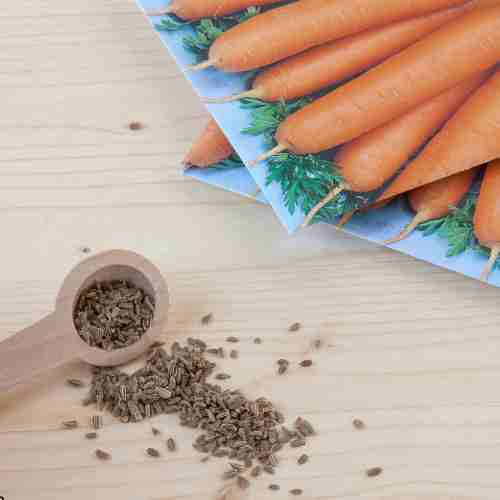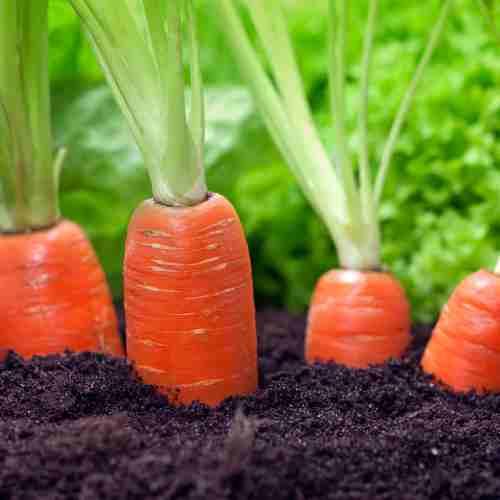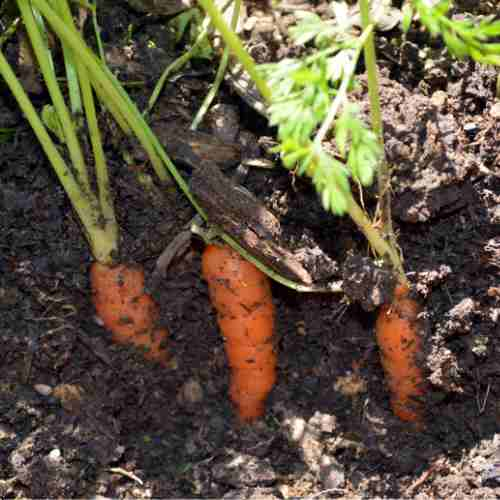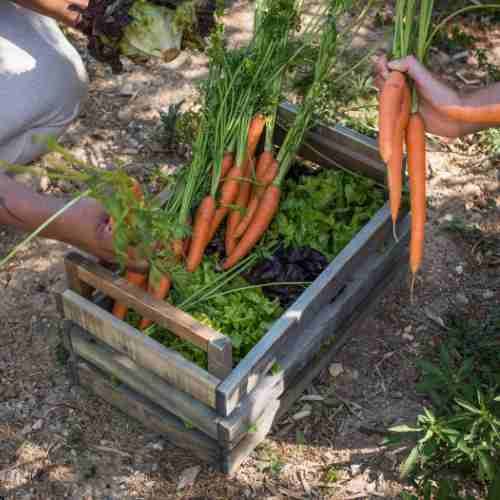How to Grow Carrots: A Beginner’s Guide

Carrots are sweet, nutritious, and a staple in many gardens worldwide. Growing carrots successfully involves choosing the right variety, proper sowing, diligent care, and managing potential challenges.
This guide will take you through all the essential steps to grow healthy and flavorful carrots, whether in your home garden or a larger outdoor space.
Check out this guide if you want to learn more about Growing Carrots Indoors.
Get our Gardening Buddy and find veggies that fit your conditions best.
You Can Grow It!
Choosing the Right Carrot Variety
Carrots come in various shapes, sizes, and colors. Selecting the right variety depends on your soil type and intended use. Here are some popular options:
- Adelaide: Early variety, ideal for sowing in late winter or early spring.
- Flyaway: Sweet orange roots with resistance to carrot fly.
- Bangor: High-yielding, excellent for main crops and long storage.
- Short-rooted types: Best for heavy or stony soils.
- Round carrots: Ideal for containers or compact spaces.
Tip:
Look for varieties with the RHS Award of Garden Merit (AGM) for reliability and quality.

Sowing Carrot Seeds
Carrots thrive in sunny spots with light, fertile, and well-drained soil. Follow these steps for successful sowing:
- Timing: Start sowing early varieties in late winter under cloches. The main sowing period is from April to early July.
- Spacing: Sow seeds 1 cm deep, in rows 15–30 cm apart.
- Thinning: Thin seedlings when they’re 5 cm tall to achieve 5–7.5 cm spacing between plants.
- Batch Planting: Sow small batches every three weeks for continuous harvests.
For container gardening, use deep pots with multipurpose compost and choose short-rooted or baby carrot varieties.

Carrot Plant Care
Healthy carrot plants require minimal but consistent care:
Watering
- Carrots are drought-resistant but benefit from occasional deep watering during prolonged dry spells.
- For container-grown carrots, water more frequently to prevent the soil from drying out.
Weeding
- Remove weeds regularly to prevent competition for nutrients and space.
- Hand-weed close to the plants to avoid disturbing the roots.
Pest Protection
- Carrot Fly: Use pest-proof mesh or a 60 cm high barrier to deter these low-flying insects.
- Slug and Snail Control: Protect young seedlings with organic deterrents.
Mulching
Apply a thin layer of mulch to retain soil moisture and suppress weeds.

Harvesting Carrots
Carrots take 12–16 weeks to mature. Here’s how to harvest them:
- Check Readiness: Roots should be at least 1 cm in diameter.
- Harvest Early for Freshness: Spring-sown carrots are sweetest when young.
- Use a Fork for Heavy Soil: Carefully lift roots to avoid breaking them.
- Staggered Harvests: Harvest only what you need to enjoy fresh carrots throughout the season.
Storing Carrots
Freshly harvested carrots are best enjoyed immediately, but they can also be stored:
- In the Refrigerator: Keep them unwashed in a perforated bag for up to a week.
- Freezing: Blanch in boiling water, then freeze for long-term storage.
- In-Ground Storage: Leave carrots in the ground over winter, covering them with straw or cardboard to prevent frost damage.

Avoid Carrot Growing Problems
Carrots take 12–16 weeks to mature. Here’s how to harvest them:
- Check Readiness: Roots should be at least 1 cm in diameter.
- Harvest Early for Freshness: Spring-sown carrots are sweetest when young.
- Use a Fork for Heavy Soil: Carefully lift roots to avoid breaking them.
- Staggered Harvests: Harvest only what you need to enjoy fresh carrots throughout the season.

Great Carrot Characteristics
Carrots Are Great for Cold Climates
Carrots are a hardy vegetable that thrives in cooler temperatures. They can be sown in early spring or late summer and left in the ground well into winter. With the right soil preparation and frost protection, carrots can provide a fresh harvest even in chilly conditions.
Carrots Can Fully Grow Indoors
Carrots can be grown indoors, making them ideal for urban gardeners or those with limited outdoor space. Use deep pots or containers with loose, well-draining soil. Place them near a sunny window or under grow lights to ensure they receive adequate light.
Carrots Fit in Small Spaces
Carrots’ compact growth habit makes them perfect for small gardens or even balcony setups. Short-rooted and round varieties are particularly well-suited to small spaces, thriving in raised beds, containers, or narrow garden rows.
Carrots are a Low-Maintenance Crop
Once established, carrots require minimal attention. They are naturally drought-resistant and can adapt to various soil types. Regular weeding and occasional watering are typically all that’s needed to keep them healthy.
Carrots Have Minimal Watering Needs
Carrots are drought-tolerant, requiring only occasional watering during dry spells. Overwatering can lead to root rot, so it’s best to water deeply but infrequently. For container-grown carrots, ensure consistent moisture to prevent the soil from drying out completely.

Conclusion
Growing carrots is a rewarding experience that provides fresh, flavorful produce for your table. By selecting the right variety, sowing properly, and maintaining diligent care, you can enjoy a nearly year-round harvest.
Follow this guide to overcome challenges and cultivate a thriving carrot crop.
You Can Grow It!
Get our Gardening Buddy and find veggies that fit your conditions best.
You Can Grow It!
Partners and Sponsors
We are forever grateful to our partners and sponsors. Send an email to team @ strongecho.com and let’s see how we can grow each other’s impact!





